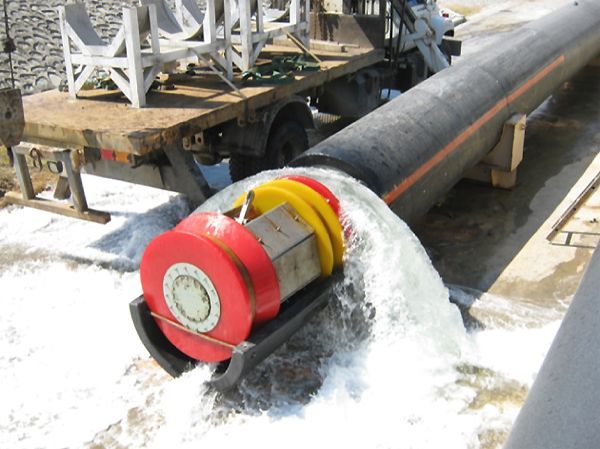By Saule Tasboulatova
 Intelligent pig (pipeline inspection gauge) for pipeline cleaning and inspection operationsThe situation in Kashagan remains uncertain. Probably, the arrival of the robot inspector (“intelligent pig” -pipeline inspection gauge) for inspection of the offshore section of the pipeline will help to identify the causes of leaks.
Intelligent pig (pipeline inspection gauge) for pipeline cleaning and inspection operationsThe situation in Kashagan remains uncertain. Probably, the arrival of the robot inspector (“intelligent pig” -pipeline inspection gauge) for inspection of the offshore section of the pipeline will help to identify the causes of leaks.
PIG INSIDE THE PIPE
The robot, or so-called “an intelligent pig” will be used for pipeline inspection activities on the island until December. By the way, it’s been over a month since the fragments of failed onshore pipes were sent to Oxford for study. So far, there were no reports about the results of that study. And what amount of time would a “clever pig” require to identify the problem? If to take into consideration the fact that Christmas is coming when nearly all expats leave Atyrau for holidays, then we can surely assume that production at Kashagan will not be re-started before 2014.
It is up to NCOC what to do with Oxford scientists’ findings and intelligent pig’s results. But the public is waiting for the announcement of the date of re-start and an honest report about environmental impacts and risks. And, of course, the public would like to have an idea about the scale of the problem that occurred after the accidents in October. For example, the public wants to know if the problem is in the pipeline only or in major and systematic violations of technology at all North Caspian project facilities as well?
DRY THE GAS
Since we haven’t got that information, then different versions have the right for existence. For example, after the first leak it was discovered that hydrates were formed in the gas pipeline that later caused pipe cracking. Why would hydrates form in the pipeline? The all-knowing Google says that “… formation of hydrates (in gas pipelines) is caused not only by temperature and pressure, but also due an insufficient drying of gas, etc. The accumulation of moisture, dust and foreign substances that in the lower parts of gas pipeline reduce the cross section of the gas pipeline, also contribute to formation of hydrates”.
And where the associated gas is dried in our case? On D island. As we know, Kashagan crude is pumped to separation unit. Separated gas with high H2S concentration is then pumped to gas drying unit. One can assume that insufficient drying of gas could be one of many reasons for hydrogen-sulphide corrosion in onshore pipelines. So, the problem with the onshore part of the pipeline could well be the consequences of offshore gas drying unit.
ABOUT FINES AND SAMPLES
The public is also concerned over another vital issue: will Kazakhstan put a claim for payment of fine to the Consortium in the amount of 120 mln dollars for the delay of the production start-up, as it was envisaged by the Second Additional Agreement to PSA. But the government keeps silent. Probably, it is still early to speak. It is still unclear whether the Kashagan start-up announced in October should be legally considered as the actual date of the production start-up. Although, all the declared targets of production volumes were not achieved. But formally the production has started, though it was suspended…
But if 120-million fine is not to be imposed for the delay, then, maybe, an ecological fine should be considered? However, the results of unscheduled inspection by the state ecologists will become known only at the end of the month.
To-date, we only know the results received by specialists of Ural-Caspian interregional basin inspectorate of fishery (under the Ministry of Environment and Water Resources). On November 12 the inspectorate took water samples in north-east part of the Kazakhstan sector of the Caspian Sea around the area where the pipeline is laid from Kashagan field.
According to Murat Ermekkaliev, acting chief of Ural-Caspian interregional basin inspection of fishery, in those water samples no phenol, oil products or hydrogen sulfide were present.
Galina Chernova, the head of “Globus” NGO, is skeptical about those results:
– It is obvious that they took water samples too late. So, to discuss about the presence of phenol and oil products that normally evaporate quickly from water surface, is not quite correct. Earlier, in 2001-2003, Agip used to invite the activists of ecological movement to Kashagan field for taking water samples and they demonstrated the operation of their equipment. Now the public has been excluded from this process, although the Orkhus convention requires the participation of ecologists in that process.
 В Атырау
+1
В Атырау
+1